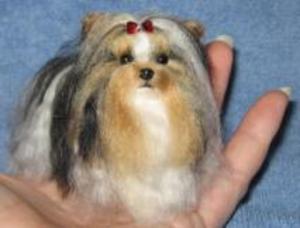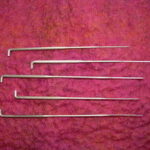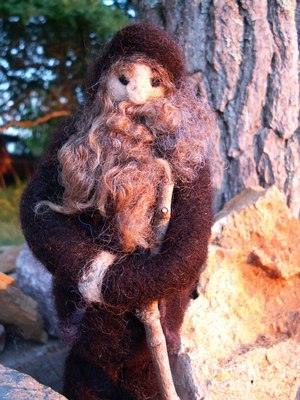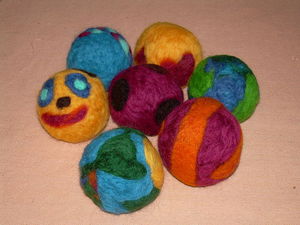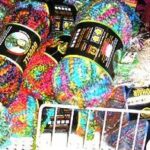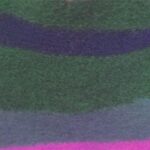When most people hear the word “felt” many think of a sheet of felt sold in art stores. If you have heard of “felting” as an art form you may have heard of the art of needle felting but, more likely are only familiar with the wet felting process, or wet felting used to give a felted texture to knitting. Even if you are familiar with this art form, this article may change your perception of what can be created with needle felting. If you are familiar with both wet felting and needle felting skip to #3, for those who have never heard of any type of felting:
1. What is felting or felted?
Felting is creating something made of interlocking fibers. Felt or felted is another way to refer to those interlocking fibers. One way to create a felted object is by wet felting, rubbing soapy wet fibers together. You can also wet felt a knitted object, by washing it. This can be used to create an object durable enough to be worn.
2. What is needle felting?
Needle felting is very different from creating a felted object out of knitting, or any other wet felting process. It does not involve knitting and it is a dry process of interlocking fibers or felting. Is it done with special barbed felting needles. These needles have also been used to root doll hair, but are available in more sizes for needle felting. The barbs on the needles catch fibers and enable them to be sculpted by hand. Typically, objects created this way aren’t durable enough to go in the wash, but can be worn as jewelry. More commonly, they are 3D sculptures, or 2D felted pictures for display only.
Now for some common misconceptions:
3. Needle felting is a “new” art form.
Needle felting has been described as a relatively new art form & as an ancient art form. Needle felting has recently gained popularity through the Internet, making it seem much newer than it really is. Sheets of fiber like, or similar to, the ones found in art stores can be created through a process of felting using barbed needles. Sheets of felted fibers are created on large machines making that process different from “needle felted” art which describes the hand sculpting process, but the ability of being able to felt fibers with barbed needles has been known since dry felted sheets have been around and the process started on a smaller scale. Felting is an ancient art form, needle felting is relatively new, but not as new as you may think.
4. Needle felting is “easy”.
Needle felting may be comparatively easy compared to wet felting knitting; you don’t have to learn to knit. The dry needle felting process is relatively simple: poking fibers with barbed needles, but that doesn’t mean anyone will immediately be able to create something that looks the way they want. Calling it “easy” can be compared to saying anyone who can hold and make marks with a pencil will find it “easy” to draw, or that anyone who can press keys on a piano will find it “easy” to play. Like any other art, needle felting is a skill that takes time to develop and everyone has their own style. There are different sizes and shapes of needles to learn to work with. It can also be somewhat dangerous, as the needles are very sharp and it’s very easy to poke yourself, and therefore this art is not recommended for young children. People with the impression that needle felting is an easy art may have a limited impression on the type of art that can be created with this art form. The pictures on this page may change your point of view:
http://mysite.verizon.net/vze91fyp/
5. Needle felting is “cheap”.
Needle felting supplies can be relatively low cost compared to other art forms such as painting. The fibers used can vary in cost and those of you familiar with the art probably know how hard it is to find materials for needle felting in most art stores. Also, art created with this process should not be valued based only on cost of materials, one reason is because this is also a very, very time consuming art form.
